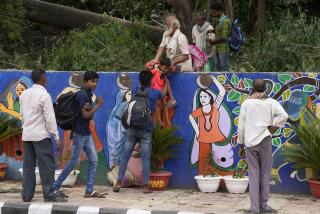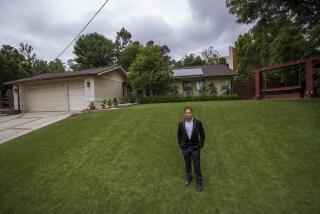Where every inch counts
- Share via
MUMBAI, INDIA — Reincarnation is Kallu Khan’s stock in trade.
His workshop floor is a swamp of cardboard strips hacked from salvaged boxes. Laborers scoop them up, work them over and give them new life as smaller boxes, which Khan then sells to stationery and packing companies.
In another warehouse a few doors down, dozens of rubber soles cut from discarded shoes also await a second chance. Next to these, a mountain of plastic castoffs -- toys, computer keyboards, car parts -- is separated by squatting workers, to be melted down into tiny pellets before being reborn in some new form.
One man’s junk is another’s fortune in Dharavi, the largest slum in India. With the economy and consumption soaring, recycling is good business here, a source of jobs for thousands, from scavengers to sorters to manufacturers.
Their collective toil is just part of the daily bustle in this teeming shantytown in India’s financial and entertainment capital. About half a million people live and work in Dharavi -- recyclers, tailors, leather tanners, laundrymen, potters, cloth dyers and shopkeepers, all jammed into a single square mile of narrow alleys and rickety buildings made from corrugated metal sheets.
They are some of Mumbai’s poorest residents. They also happen to be sitting on some of the world’s most valuable real estate.
In a boomtown starved for room to grow, Dharavi occupies a prime location at the junction of two commuter rail lines close to the heart of the city. One of Mumbai’s swankiest new business parks, the Bandra-Kurla Complex, a diorama of concrete and glass that shimmers in the tropical heat like a mirage of order and progress, looms just beyond a fetid bog of mangroves used by many of the slum dwellers as a toilet.
Because of their location, Dharavi’s residents have been locked for years in a tug of war with government officials who look hungrily at such choice land and dream their own dreams of reincarnation.
If the officials get their way, the slum will be demolished and reborn as a gleaming collection of high-rise apartments, office towers and manicured parks. Residents who arrived before 2000 would be re-housed elsewhere in Dharavi in small flats of 225 square feet -- smaller than a suburban American garage -- while an influx of richer folk and big companies would turn the area into one of Mumbai’s fashionable addresses.
But many who live here take fierce pride in a community that they and their families built, for some over several generations, with little help from the state. They refuse to be uprooted without a fight.
“This is like my country now,” said Ramakant Rai, a grizzled electrician who has lived in Dharavi for 35 years, most of them in a shack built right up against a massive water pipe laid down during the British Raj. “I say to the government, let us stay here and we’ll build our own houses.”
It is a war of wills, the outcome of which could have far-reaching consequences. What happens to Dharavi could presage the fate of the rest of Mumbai’s many slums, home to half of the metropolis’ population of 16 million.
The slums are the first thing many visitors to this city see. Arriving air travelers gaze down on the winking metal roofs of another large shantytown that has pushed right to the edge of the tarmac.
In many ways, the battle over Dharavi is a battle over how India sees itself and the image it wants to project as a rising power.
With a competitive eye on China to the east and an envious eye on developed countries to the west, India’s leaders and elites are yearning to prove that their country belongs in the same league. They want Mumbai mentioned in the same breath as Shanghai, New York and London, a world-class city that embodies the new India of stock markets, cocktail bars and Bollywood glamour.
Having what is possibly Asia’s biggest slum does not fit into that ideal, especially when the slum occupies premium property in a city where commercial rents can approach $2,000 per square foot. In addition to the nearby train lines, Dharavi lies just a few miles from the airport, making it especially attractive to Indian and foreign businesspeople.
“You’re talking of a location that’s fantastic. This is the only location in Mumbai where I can bulldoze 500 acres of land and redesign,” said architect Mukesh Mehta, whose $3-billion redevelopment plan was adopted by the Maharashtra state government in 2004 but has been subject to repeated debate and delay.
His goal is to “create a brand-new beautiful suburb,” complete with green space, schools, hospitals and reliable public services such as sanitation, things Dharavi currently lacks.
All costs are to be borne by the developers, who still will profit handsomely from the high rents charged to companies and people Mehta calls “mainstream,” by which he means the middle and upper classes. The slum dwellers will receive nicer housing than they have now, he insists.
It is an ambitious plan for Mumbai, where failed examples of redevelopment dot the landscape: buildings abandoned halfway through construction, others in disrepair because of mismanagement and corruption.
The U.S.-educated Mehta says his plan offers “quantum leaps” of improvement for Dharavi, a place he once referred to as a “black hole.”
Many residents bristle when they hear such terms. They dislike the word “slum,” which they feel conjures up an image of misery and torpor.
Squalor and wretchedness definitely exist. Rats scuttle along the gutters. Women wring out the day’s wash in open drains while their children play cricket between heaps of rotting garbage. In some parts of Dharavi, several families share a single tap, and even more families share a single toilet -- or simply do their business in open areas. Stray dogs add to the stench.
But there are no idle hands here. Dharavi is a hive of activity, a marvel of entrepreneurial spirit and hard work that, in its own way, is as much a reflection of the new India and its go-go economy as the glass offices of the business park across the way.
Estimates of the number of informal businesses and cottage industries operating in Dharavi range anywhere from 5,000 to 15,000, with revenue totaling tens, if not hundreds, of millions of dollars a year.
The air resounds with the whine of machines and shouts of workers. Trucks laden with goods rumble by on the larger paved roads, past grocery stalls, eateries, bank branches, temples and mosques.
Once a fishermen’s colony on the northern edge of Bombay, as Mumbai was then known, Dharavi is now almost a city within a city -- a self-contained, chaotic but somehow functional world, and a magnet for migrants. Nearly all of India’s many languages can be heard here, in close-knit enclaves often defined by the residents’ origin or occupation.
Khan, the cardboard-box recycler, languished as a farmer in Uttar Pradesh, India’s most populous state, before landing here eight years ago looking for something better. He is constantly hustling, a go-getter attitude that enabled him to buy his own workshop in 2006. The property has nearly doubled in value since, he said.
Khan, 40, oversees seven employees, all recruits from his home village. As his own boss, he is able to go home for lunch with his wife and five children every day.
In a good month on the farm, Khan earned 6,000 rupees (about $140). Here, monthly revenue can be 50 times that.
“Why would I go back?” he asked rhetorically as he relaxed for a few minutes on a stack of collapsed boxes.
The redevelopment plan, many residents of Dharavi say, will force them from their homes and businesses and into tiny apartments. Though some slum dwellers now live in even more cramped quarters, many have grafted second and third stories onto their shanties, which they rent out or use to run small businesses.
“The poor and the working class won’t be able to stay in Mumbai,” said 40-year-old Usman Ghani. “Many years ago, corrupt leaders sold this country to the East India Co. Now they’re selling it to multinationals.”
Ghani, who was born and raised in Dharavi, is a third-generation potter in the slum’s famous potters colony, which boasts craftsmen whose wares are known throughout Mumbai and beyond. At his wheel, Ghani throws about 40 water pots a day, which he fires overnight in a large brick kiln a few steps outside his open-air studio.
“I’ve never been inside a tall building. I prefer a place like this where I can work and live,” Ghani said, his hands and face flecked with wet clay.
Last summer, Ghani joined thousands of others from Dharavi in a protest that turned one stretch of road into a half-mile-long sea of multicolored flags and banners.
Slum-dweller activists contend that if the plan goes through, much, if not most, of the informal economic activity in Dharavi will be curtailed from lack of space and that cohesive communities will be broken up. Architect Mehta acknowledges that “nobody will get 100% of what they have” now, but he insists that many industries will still have room to operate.
Rai, the electrician whose home abuts the big water pipe, said it probably would be harder for him to make a living if he and his neighbors were resettled in anonymous high-rises.
“I’ve never locked my door, because I know everyone around here,” said Rai, a burly, cheerful man in his 50s. “The people out here respect me. I don’t allow anyone to rob or steal. If someone does something wrong, I haul him over to the creek and give him a thrashing.”
From atop the water pipe, Rai can look out over the mangrove swamp and count the tall, shiny office buildings on the other side, the kind the government would like to plant on the spot where he and his family now live.
But Rai does not appear overly worried about the prospect.
In 3 1/2 decades of living in Dharavi, he has heard politicians and officials talk big before about reclaiming and rehabilitating this place.
Those politicians and officials are gone now. Dharavi -- with all its failings and problems, its chaos and unruliness -- remains.
--
More to Read
Inside the business of entertainment
The Wide Shot brings you news, analysis and insights on everything from streaming wars to production — and what it all means for the future.
You may occasionally receive promotional content from the Los Angeles Times.











